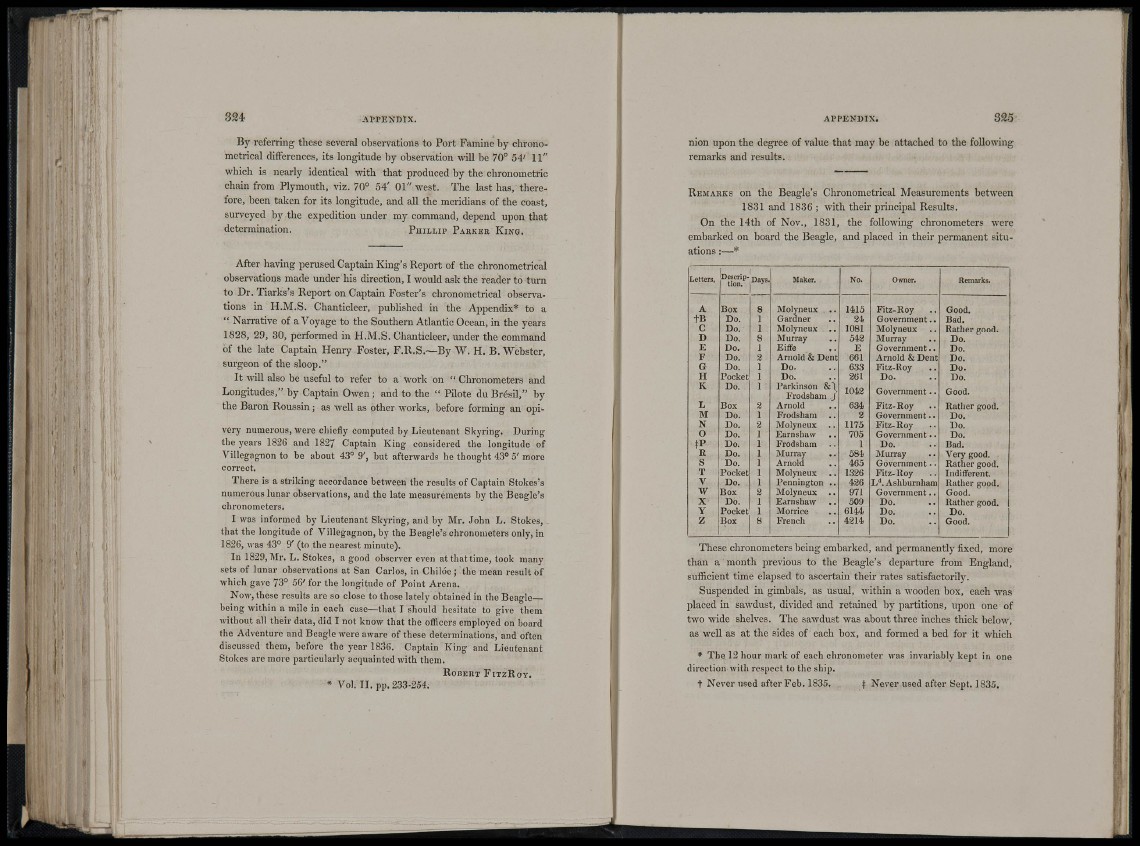
• I " r
, A
F R I
i'H. t
»»4' APPENDIX.
By referring these several observations to Port Famine by chronometrioal
differences, its longitude by observation will be 70° 54' 11"
which is nearly identical with that produced by the chronometric
chain from Plymouth, viz. 70° 54' 01" west. The last has, therefore,
been taken for its longitude, and all the meridians of the coast,
surveyed by the expedition under my command, depend upon that
d e t e r m i n a t i o n . PH I L L I P PARKEE KING.
After having perused Captain King' s Report of the elironometrical
observations made under his direction, I would ask the reader to turn
to Dr. Tiarks' s Report on Captain Foster's chronometrical observations
in H.M.S. Chanticleer, pubhshed in the Appendix* to a
" Narrative of a Voyage to the Southern Atlantic Ocean, in the years
1828, 29, 30, performed in H.M.S. Chanticleer, under the command
of the late Captain Henry Foster, F. I l .S.~By W. H. B. Webster,
surgeon of the sloop."
I t will also be useful to refer to a work on " Chronometers and
Longitudes," by Captam Owen ; and to the " Pilote du Brésil," by
the Baron Roussm ; as well as other works, before forming an opi-
VC17 numerous, were chiefly computed by Lieutenant Skyring. During
the years 1826 and 1827 Captain King considered the longitude of
Villegagnon to be about 43° 9', but afterwards he thought 43° 5' more
correct.
There is a sti-iking accordance between the results of Captain Stokes's
numerous lunar observations, and the late measurements by the Beagle's
chronometers.
I was informed by Lieutenant Skyring, anil by Mr. John L. Stokes, -
that the longitude of Villegagnon, by the Beagle's chronometers only, in
1826, H as 43° 9' (to the nearest minute).
In 1829, Mr, L. Stokes, a good observer even at that time, took many
sets of lunar observations at San Carlos, in Chiloe ; the mean result Of
which gave 73° 56' for the longitude of Point Arena.
Now, these results are so close to those lately obtained in the Beaglebeing
within a mile in each case—that I should hesitate to give them
without all their data, did I not know that the officers employed on board
the Adventure and Beagle were aware of these determinations, and often
discussed them, before the year 1836. Captain King and Lieutenant
Stokes are more particularly acquainted with them.
ROBERT FITZROY.
* Vol. I I . pp. 233-254.
A P P E N D I X . 325
nion upon the degree of value that may be attached to the following
remarks and results.
REMARKS on the Beagle's Chronometrical Measurements between
1831 and 1836 ; with their principal Results.
On the 14th of Nov., 1831, the following chronometers were
embarked on board the Beagle, and placed in their permanent situations
:—*
Letters. ÌDescrlption.
^Days. Maker. No. Owner. Remarks.
A Box 8 Molyneux .. 1415 Fitz-Roy Good.
+B Do. 1 Gardner 21 Government.. Bad.
C Do, 1 Molyneux .. 1081 Molyneux .. Rather good.
D Do. 8 Murray 542 Murray Do.
E Do. 1 Eiffe E Government.. Do.
F Do. 2 Arnold & Dent 661 Arnold & Dent Do.
G Do. 1 Do. 6.33 Fitz-Roy Do.
H Pocket 1 Do. 261 Do. Do.
K Do. 1 Parkinson
Frodsham J 1042 Government.. Good.
L Box 2 Arnold 634 Fitz-Roy Rather good.
M Do. 1 Frodsham .. 2 Government.. Do.
N Do. 2 Molyneux .. 1175 Fitz-Roy Do.
0 Do. I Earnshaw 705 Government. - Do.
tP Do. 1 Frodsham .. I Do. Dad.
R Do. 1 Murray
Arnold
584 Murray Very good.
S Do. 1 Rather good.
465 Government -.
T Pocket 1 Molyneux .. 1326 Fitz-lloy Inditferent.
V Do. 1 Pennington .. 426 L**. Ashbm'nham Rather good.
W Box 2 Molyneux .. 971 Government.. Good.
X Do. 1 Earnshaw .. 509 Do. Rather good.
Y Pocket 1 Morrice 6144 Do. Do.
Z Box 8 French 4214 Do. Good.
These chronometers being embarked, and permanently fixed, more
than a month previous to the Beagle's departure fi-om England,
sufficient time elapsed to ascertain then- rates satisfactorily.
Suspended in gimbals, as usual, within a wooden box, each was
placed in sawdust, divided and retained by partitions, upon one of
two wide shelves. The sawdust was about three inches thick below,
as well as at the sides of each box, and formed a bed for it which
* The 12 hour mark of each chronometer was invariably kept in one
direction with respect to the ship.
+ Never used after F eb. 1835. t Never used after Sept. 1835.